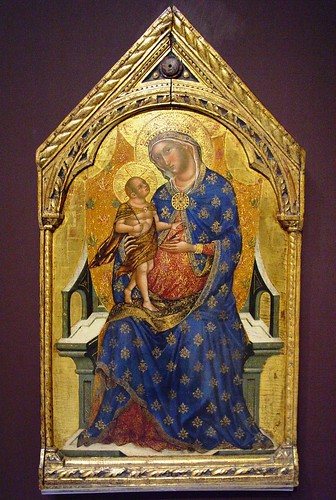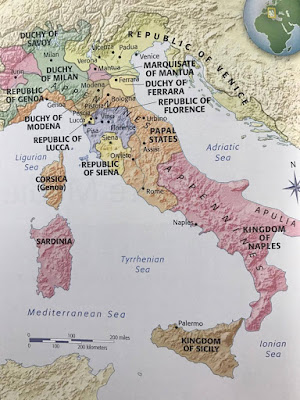late medieval italy
fig. 14-1
territorial divisions:
-duchy-republic
-kingdom
- rome, orvieto, assisi, etc. = lots of religious artwork
- as you move away, more secular & diverse
altarpiece configurations:
-diptych
-triptych
-polyptych
-triptych
-polyptych
centers of urban development:
-milan
-florence
-siena
-venice
-rome
-urbino
-milan
-florence
-siena
-venice
-rome
-urbino
key artists:
-nicola pisano: sculptor of relief panels
-cimabue
-giotto: "first renaissance painter," pursued naturalistic approach
-duccio: master of sienese school of painting
-paolo veneziano
-simone martini
-ambrogio lorenzetti
-andrea pisano
-cimabue
-giotto: "first renaissance painter," pursued naturalistic approach
-duccio: master of sienese school of painting
-paolo veneziano
-simone martini
-ambrogio lorenzetti
-andrea pisano
- oculus= "eye of God"
_______________________________________________________________
duecento (13th century)
- diversity of style
- some artists worked in the maniera greca (italo-byzantine style), some in the mode of gothic france, & others in the newly revived classical naturalistic tradition
ART & SOCIETY: ITALIAN ARTISTS' NAMES
-many individuals were known by their place of birth or adopted hometown
-format of names could also be changed whenever
________________________________________________________________
FLASHBACK: GRECO-ROMAN PROTOTYPES
FLASHBACK: BYZANTINE ERA PROTOTYPES
-refers to 4th century societal shift in Rome: Constantine declared Christianity as official religion
-ancient greek city of Byzantium becomes new capital of Christendom- renamed Constantinople
-style: figurative art- austere & conservative
byzantine characteristics:
RELIGION & MYTHOLOGY:
-italians resented the avignon papacy
-conflict btwn french & italians-> election of 2 popes (1378)-> Great Schism
-increase in monastic orders-> constant religious presence
-mendicants (begging friars): renounced worldly goods, preached to large urban crowds
-rivalry btwn franciscans & dominicans
-confraternities: organizations of laypersons who dedicated themselves to strict religious observance
the Black death (europe, circa 1347-51)
-origin: china -> trade ships at port of sicily -> flea infested rodents
-physical ramifications: inflammation of lymph nodes (groin & armpits), black pus, rapid contagion
-social effect: fear, ostracization, isolationism, irrational behavior
-psychological effect: introversion, "memento mori" (remember, you too will die)
-effect on faith/religion: intervention of omnipotent being- mass exodus, skepticism
-long-term effect: open to humanism
-stats: 60% loss of population
FLASHBACK: GRECO-ROMAN PROTOTYPES
 |
| kalos thanatos (a beautiful death?)/ sarcophagus/ kline (recline)/ meander motif/ register/ arcade |
- meander motif: represents new life
- register: horizontal band
FLASHBACK: BYZANTINE ERA PROTOTYPES
-refers to 4th century societal shift in Rome: Constantine declared Christianity as official religion
-ancient greek city of Byzantium becomes new capital of Christendom- renamed Constantinople
-style: figurative art- austere & conservative
byzantine characteristics:
- rigid body pose
- emphatic verticality (columnar body)
- multiple striations (registers)
- stoic stare
- almond eyes
- elongated nose/fingers
- colors: blue & gold (heavenly realm/unique mandate)
- flatness of forms
- body concealment
_________________________________________________________________________
RELIGION & MYTHOLOGY:
-italians resented the avignon papacy
-conflict btwn french & italians-> election of 2 popes (1378)-> Great Schism
-increase in monastic orders-> constant religious presence
-mendicants (begging friars): renounced worldly goods, preached to large urban crowds
-rivalry btwn franciscans & dominicans
-confraternities: organizations of laypersons who dedicated themselves to strict religious observance
fig. 14-5
 |
| Saint Francis Altarpiece- Bonaventura Berlinghieri Italy, 1235, tempera on wood Italo-Byzantine style/maniera greca highlights increasingly prominent role of religious orders (Great Schism) |
____________________________________________________________________
Trecento (14th century)
-origin: china -> trade ships at port of sicily -> flea infested rodents
-physical ramifications: inflammation of lymph nodes (groin & armpits), black pus, rapid contagion
-social effect: fear, ostracization, isolationism, irrational behavior
-psychological effect: introversion, "memento mori" (remember, you too will die)
-effect on faith/religion: intervention of omnipotent being- mass exodus, skepticism
-long-term effect: open to humanism
-stats: 60% loss of population
- renaissance= rebirth of art & culture
- humanism: human values & interests distinct from religion's otherworldly values
- scholars & artists became increasingly concerned w the natural world
fig. 14-8
- stigmata: wounds of Christ
- iconography: study of symbols & representations of subject matter
Christian iconography:
- annunciation: white lilies, mary, gabriel
- nativity: baby Christ, mary, joseph
- pedagogy: teachings of Christ/parables
- miracles
- passion: crucifixion, Resurrection
- pentecost: after he comes back
MATERIALS & TECHNIQUES: FRESCO PAINTING
-mural painting technique
-buon fresco: (true fresco) apply permanent limeproof pigment, diluted in water, on fresh lime plaster
-one of the most durable painting techniques
-fresco secco: (dry fresco) painting on dried lime plaster, plaster wall does not absorb pigments
fig. 14-9
THE PATRON'S VOICE:
-guilds: associates of master craftspeople, apprentices, & tradespeople
-monastic orders, confraternities, & the Vatican were major art patrons
-a patron's needs/wishes were crucial
ART & SOCIETY: ARTISTIC TRAINING IN RENAISSANCE ITALY
-aspiring artists started training at 7-15 yrs old
-fathers would negotiate an arrangement w a master artist
-boys served as apprentices
-after completing apprenticeships, artists entered appropriate guilds
-new guild-certified artists served as assistants to master artists until established reputations
fig. 14-14
SECULAR WORLD VIEW:
International Gothic:
- Gothic 13th & 14th cent.: images of city of God which they were privileged to build on earth
- byzantine characteristics w excessive decorative flourishes
-pointed arches
-lux nova
-rose windows
-tri foria
-light
-airy
-vertical
-soaring
-unified
-unbroken space
-exterior buttresses
-ribbed groin vaults, bright
-richly decorated w sculpture
 |
| madonna & child- paolo veneziano 1340, oil |
fig. 14-14
 |
| annunciation- simone martini 1333 over the top- gold leaf & big wings mary's body language= reacting dialogue in latin multiple strands of lilies |
SECULAR WORLD VIEW:
fig. 14-17
 |
| peaceful city (siena)- lorenzetti brothers frescoes in situ- palazzo publico, siena circa 1338 buildings are isometric prosperity/growth frescoes in situ |
fig. 14-18
 |
| peaceful country- lorenzetti brothers counterpart of peaceful city frescoes in situ- palazzo publico, siena |
fig. 14-19











No comments:
Post a Comment